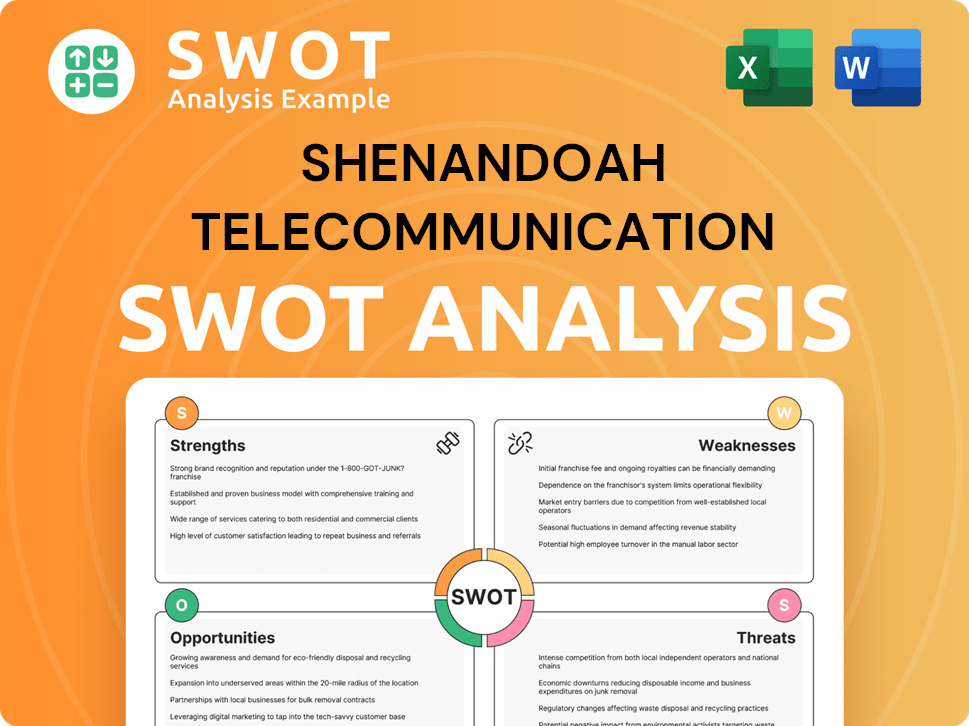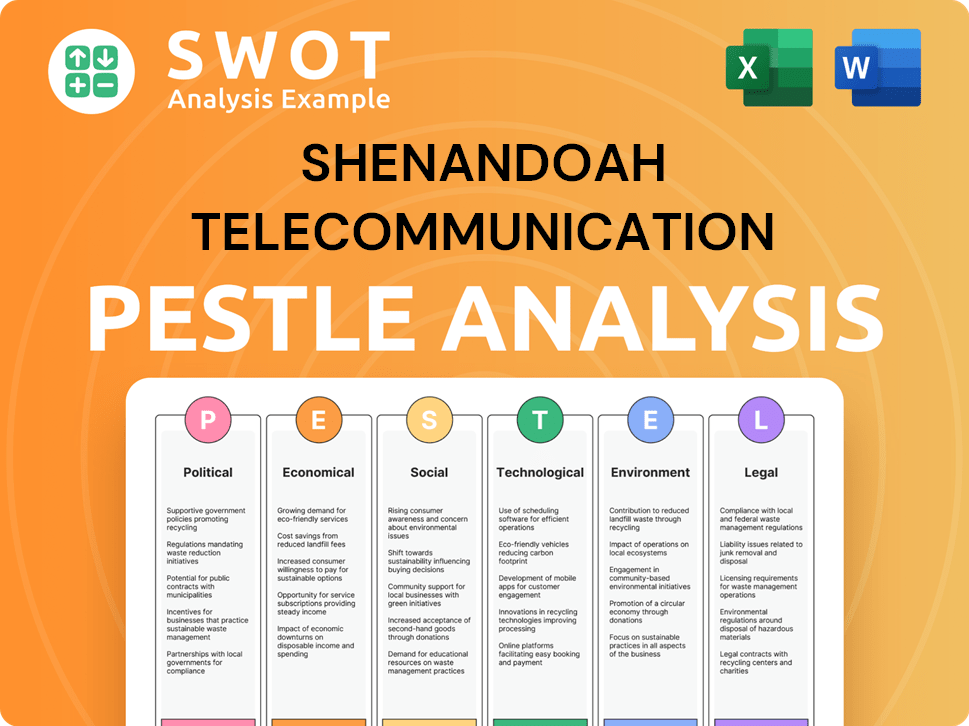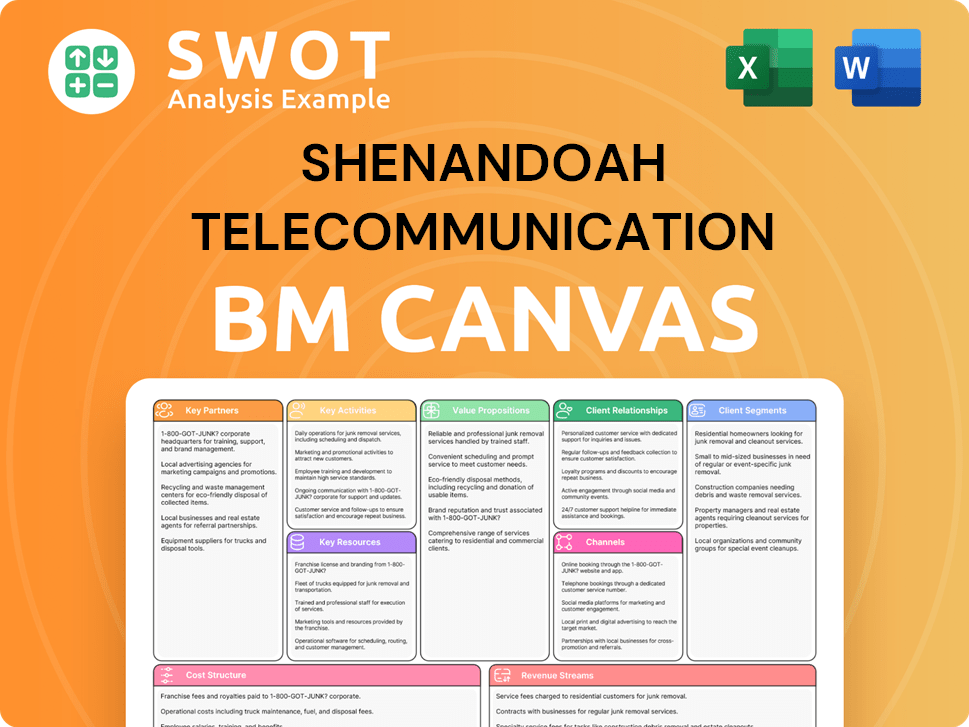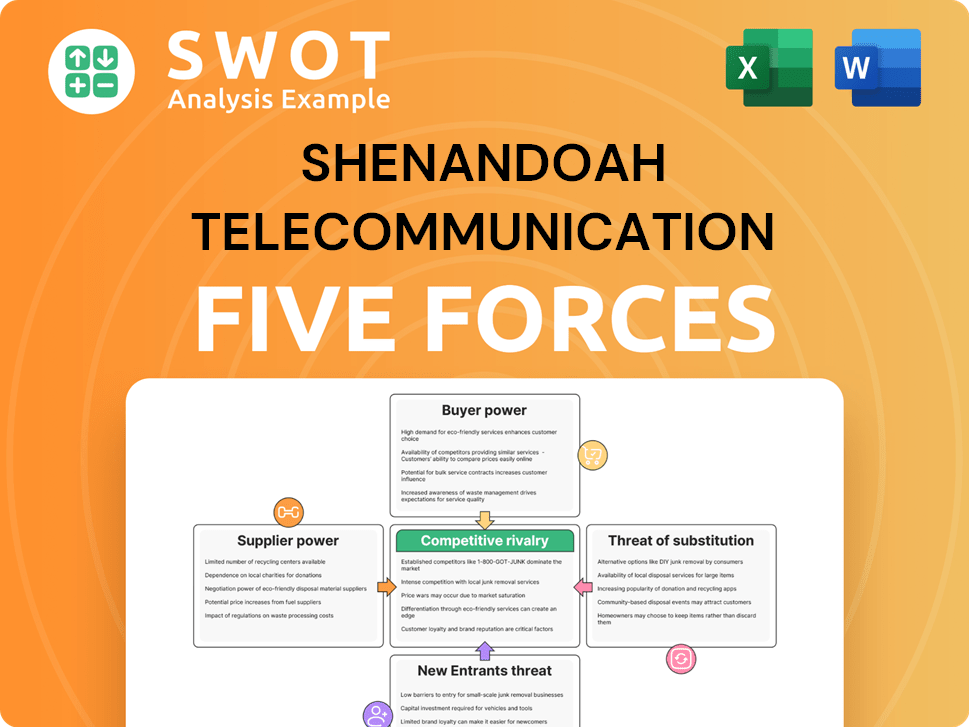Shenandoah Telecommunication Bundle
Who Does Shenandoah Telecommunication Company Serve?
In the ever-evolving telecommunications landscape, understanding the Shenandoah Telecommunication SWOT Analysis is crucial. For Shenandoah Telecommunication Company (STC), identifying its customer demographics and target market is more than just an analysis; it's the foundation of its strategic success. The demand for high-speed internet, fueled by remote work and digital entertainment, has reshaped the industry, making it vital for STC to precisely understand and cater to its customer base.

This exploration delves into the specifics of STC's customer base, examining their customer profile and how the company adapts to their needs. We'll analyze the market segmentation strategies employed by STC, focusing on aspects such as age demographics of STC users, income levels of STC customers, and geographic location of STC's target market. Furthermore, we'll discuss STC's customer acquisition strategies and customer retention strategies to understand how STC effectively addresses the communication needs of its target market within a competitive landscape.
Who Are Shenandoah Telecommunication’s Main Customers?
Understanding the customer base of the Shenandoah Telecommunication Company, or STC, involves examining its primary customer segments. STC's operations are primarily focused on the Mid-Atlantic region, and it serves both residential consumers and businesses. This market segmentation strategy allows STC to tailor its services to meet specific needs, ensuring a targeted approach to customer acquisition and retention.
The company's target market is split into two main categories: business-to-consumer (B2C) and business-to-business (B2B). The B2C segment focuses on households, while the B2B segment targets small and medium-sized businesses (SMBs). This dual approach allows STC to address a broad range of communication needs within its service area.
Key aspects of STC's customer demographics and target market include a focus on high-speed internet services. For residential customers, this often means households that value reliable and fast internet for activities such as streaming, remote work, and online education. Businesses, on the other hand, require dependable internet, voice, and data solutions to support their operations. The company's strategic shift towards fiber broadband highlights its commitment to meeting the evolving needs of both customer segments.
The residential customer profile typically includes households that prioritize high-speed internet. This includes those who need it for streaming, remote work, and online education. While specific data on age, income, and education levels are proprietary, the demand for fiber broadband suggests a customer base that values speed and reliability.
The B2B segment primarily targets small and medium-sized businesses (SMBs). These businesses require dependable internet, voice, and data solutions. The focus is on providing services that support business continuity, scalability, and secure network access. STC also provides tower colocation services to wireless carriers.
STC's market segmentation strategy focuses on two main groups: consumers (B2C) and businesses (B2B). This approach allows STC to tailor its services to meet the specific needs of each segment. The company's fiber broadband expansion is a key driver of growth in both residential and business markets.
The divestiture of wireless assets to T-Mobile in 2021 allowed STC to concentrate on broadband and fiber network expansion. This strategic pivot was driven by market consolidation and a desire to leverage its core competencies in fixed broadband services. The company's focus is on expanding its fiber-to-the-home (FTTH) deployments.
STC's customer base is influenced by several demographic and technological trends. The increasing demand for high-speed internet, driven by remote work and streaming, is a major factor. The company's expansion of fiber broadband is a direct response to these trends, targeting customers who value speed and reliability.
- The shift towards fiber-to-the-home (FTTH) deployments is a significant driver of new residential subscriptions.
- The B2B segment benefits from the growing need for dependable internet and data solutions among SMBs.
- STC's strategic focus on fixed broadband services positions it to capitalize on market opportunities.
- The company's market share and competitive landscape are influenced by these trends.
Shenandoah Telecommunication SWOT Analysis
- Complete SWOT Breakdown
- Fully Customizable
- Editable in Excel & Word
- Professional Formatting
- Investor-Ready Format

What Do Shenandoah Telecommunication’s Customers Want?
Understanding the needs and preferences of customers is crucial for any telecommunications company. For Shenandoah Telecommunication Company (STC), this involves recognizing the distinct requirements of both residential and business clients. This customer-centric approach allows STC to tailor its services, ensuring customer satisfaction and driving business growth.
The primary drivers for residential customers are reliable and high-speed internet. Businesses, on the other hand, prioritize dependable connectivity and scalable solutions. STC's focus on these key areas allows it to meet the diverse needs of its customer base effectively.
STC's customer base is diverse, with needs varying based on whether they are residential or business customers. The company's ability to understand and cater to these different segments is key to its success in the competitive telecommunications market.
Residential customers of STC primarily need reliable, high-speed internet. They often prioritize consistent bandwidth and low latency for streaming, smart home devices, and remote work. Purchasing decisions are influenced by speed tiers, pricing, and bundled services.
Business customers require business continuity, secure data transmission, and scalable solutions. Their main goals are to enhance operational efficiency and support critical business applications. Downtime and insufficient bandwidth are significant pain points.
Customer service reputation, network reliability, and competitive pricing are critical for both customer segments. For residential customers, the demand for symmetrical speeds is increasing. Businesses require service level agreements (SLAs) and dedicated support.
STC addresses customer needs through its investment in its fiber network. This directly meets the growing demand for robust and future-proof connectivity. Customer feedback influences product development, leading to higher speed tiers and enhanced service features.
The expansion of STC's fiber network into new areas directly responds to the unmet need for reliable, high-speed internet. This expansion is a key strategy to capture market share and enhance customer satisfaction. STC's investment in fiber is ongoing.
STC gathers customer feedback through direct interactions and service calls. This feedback is crucial for product development and service improvements. Customer satisfaction scores and Net Promoter Scores (NPS) are key metrics.
STC employs market segmentation to tailor its services to different customer groups. This includes residential and business segments, each with distinct needs and preferences. Understanding these segments allows STC to optimize its offerings and marketing efforts.
- Residential: Focus on high-speed internet, streaming, and smart home compatibility.
- Business: Prioritize business continuity, data security, and scalable solutions.
- Market segmentation allows STC to target its marketing efforts more effectively.
- STC uses data analytics to understand customer behavior and preferences.
Shenandoah Telecommunication PESTLE Analysis
- Covers All 6 PESTLE Categories
- No Research Needed – Save Hours of Work
- Built by Experts, Trusted by Consultants
- Instant Download, Ready to Use
- 100% Editable, Fully Customizable

Where does Shenandoah Telecommunication operate?
The geographical market presence of the company, STC, is primarily concentrated in the Mid-Atlantic region of the United States. This includes significant operations in Virginia, West Virginia, Maryland, and Pennsylvania. STC has cultivated a strong market share and brand recognition, especially in more rural and suburban areas. The company's strategic focus on fiber buildouts significantly influences the distribution of sales and growth.
STC's ongoing fiber expansion is a key element of its market strategy. In 2024, the company continued to extend its Glo Fiber service to new communities. This expansion demonstrates a commitment to broadening its reach within its existing footprint and entering adjacent markets. The company's approach involves careful market analysis to identify areas with high demand for fiber broadband and limited competition, driving its strategic expansions.
STC tailors its marketing campaigns to specific community events and regional needs, reflecting an understanding of the differences in customer demographics and preferences across its service areas. This localization strategy is crucial for effectively targeting both residential and business customers. The Glo Fiber brand is central to its market entry and expansion strategy, aiming to capture new customers in these targeted geographic areas. For detailed insights into the financial aspects, consider exploring the Revenue Streams & Business Model of Shenandoah Telecommunication.
STC's primary geographic focus is the Mid-Atlantic region, including Virginia, West Virginia, Maryland, and Pennsylvania. This concentration allows for efficient resource allocation and targeted marketing efforts. The company leverages its established presence to capitalize on regional growth opportunities.
The company's fiber buildouts are a critical driver of market growth. STC's Glo Fiber service expansion brings high-speed internet to new communities. This strategy aims to increase customer acquisition and strengthen market share in targeted areas.
STC customizes its marketing strategies to address the specific needs of each community. This approach helps in effective customer acquisition and retention. Market segmentation allows STC to tailor its services to different customer profiles.
STC operates in a competitive market, particularly in the broadband sector. The company's focus on fiber-to-the-home services helps it to differentiate itself. STC aims to maintain and grow its market share through strategic expansions and service enhancements.
STC employs various strategies to acquire and retain customers, including targeted marketing campaigns and competitive pricing. The company focuses on delivering high-quality services to ensure customer satisfaction and loyalty. Customer demographics are key to these strategies.
STC continuously analyzes demographic trends to refine its market strategies. This includes understanding the age demographics and income levels of its target market. The company uses market analysis to identify areas with high growth potential.
Shenandoah Telecommunication Business Model Canvas
- Complete 9-Block Business Model Canvas
- Effortlessly Communicate Your Business Strategy
- Investor-Ready BMC Format
- 100% Editable and Customizable
- Clear and Structured Layout

How Does Shenandoah Telecommunication Win & Keep Customers?
Customer acquisition and retention strategies are crucial for the success of any telecommunications company. For Shenandoah Telecommunication Company (STC), these strategies involve a blend of traditional and digital marketing, sales tactics, and a strong focus on customer service and network reliability. Understanding the customer demographics and target market is fundamental to tailoring these strategies effectively.
STC's approach to customer acquisition is multifaceted, employing direct mail, local advertising, and community outreach, especially in areas with new fiber expansions. Digital marketing, including search engine marketing (SEM), social media advertising, and targeted online campaigns, is also a cornerstone of their strategy. Promotional pricing and bundled service offers are used to attract new subscribers. The Glo Fiber brand is central to attracting new fiber customers, emphasizing symmetrical speeds and reliability.
Customer retention is a key focus, with the company prioritizing excellent customer service, network reliability, and competitive pricing. STC likely uses customer data and CRM systems to segment its customer base and personalize communications and offers. After-sales service, including technical support and prompt issue resolution, is critical for minimizing customer churn, and the company's ongoing investment in network upgrades, particularly fiber optic expansion, serves as a significant retention tool.
STC utilizes a variety of channels to acquire new customers. These include direct mail campaigns, local advertising, and community outreach programs. Digital marketing strategies such as SEM and social media advertising are also key components of their acquisition efforts.
STC employs promotional pricing and bundled service offers to incentivize sign-ups. The Glo Fiber brand is a central element of their acquisition strategy, emphasizing symmetrical speeds and reliability to attract new fiber customers.
STC focuses on customer retention by providing excellent customer service, ensuring network reliability, and offering competitive pricing. They likely use customer data and CRM systems for segmentation and personalized offers.
Ongoing investment in upgrading network infrastructure, particularly the expansion of the fiber optic network, is a significant retention tool. This provides a superior and future-proof service, enhancing customer loyalty.
STC's success in acquiring and retaining customers is driven by a combination of effective marketing, competitive pricing, and a commitment to superior service. The company's focus on fiber broadband, following the divestiture of its wireless operations, allows for more focused marketing and sales efforts on its core broadband products.
- Customer Service: Providing excellent customer service is critical for minimizing churn.
- Network Reliability: Ensuring a reliable network is crucial for customer satisfaction.
- Competitive Pricing: Offering competitive pricing helps attract and retain customers.
- Fiber Optic Expansion: Investing in fiber optic infrastructure provides a superior service and enhances customer retention.
Shenandoah Telecommunication Porter's Five Forces Analysis
- Covers All 5 Competitive Forces in Detail
- Structured for Consultants, Students, and Founders
- 100% Editable in Microsoft Word & Excel
- Instant Digital Download – Use Immediately
- Compatible with Mac & PC – Fully Unlocked

Related Blogs
- What are Mission Vision & Core Values of Shenandoah Telecommunication Company?
- What is Competitive Landscape of Shenandoah Telecommunication Company?
- What is Growth Strategy and Future Prospects of Shenandoah Telecommunication Company?
- How Does Shenandoah Telecommunication Company Work?
- What is Sales and Marketing Strategy of Shenandoah Telecommunication Company?
- What is Brief History of Shenandoah Telecommunication Company?
- Who Owns Shenandoah Telecommunication Company?
Disclaimer
All information, articles, and product details provided on this website are for general informational and educational purposes only. We do not claim any ownership over, nor do we intend to infringe upon, any trademarks, copyrights, logos, brand names, or other intellectual property mentioned or depicted on this site. Such intellectual property remains the property of its respective owners, and any references here are made solely for identification or informational purposes, without implying any affiliation, endorsement, or partnership.
We make no representations or warranties, express or implied, regarding the accuracy, completeness, or suitability of any content or products presented. Nothing on this website should be construed as legal, tax, investment, financial, medical, or other professional advice. In addition, no part of this site—including articles or product references—constitutes a solicitation, recommendation, endorsement, advertisement, or offer to buy or sell any securities, franchises, or other financial instruments, particularly in jurisdictions where such activity would be unlawful.
All content is of a general nature and may not address the specific circumstances of any individual or entity. It is not a substitute for professional advice or services. Any actions you take based on the information provided here are strictly at your own risk. You accept full responsibility for any decisions or outcomes arising from your use of this website and agree to release us from any liability in connection with your use of, or reliance upon, the content or products found herein.